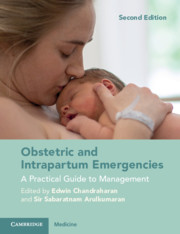Book contents
- Obstetric and Intrapartum Emergencies
- Obstetric and Intrapartum Emergencies
- Copyright page
- Contents
- Contributors
- Preface
- Preface to the First Edition
- Acknowledgements
- Section 1 General Principles
- Section 2 Algorithms for Management of the Top Five ‘Direct Killers’
- Chapter 3 Management of Deep-Vein Thrombosis and Pulmonary Embolism
- Chapter 4 Management of Severe Preeclampsia and Eclampsia
- Chapter 5 Management of Massive Obstetric Haemorrhage
- Chapter 6 Management of Septicaemia and Septic Shock Antepartum, Intrapartum and Postpartum
- Chapter 7 Management of Amniotic Fluid Embolism
- Section 3 Intrapartum Emergencies
- Section 4 Postpartum Emergencies
- Section 5 Medical and Surgical Emergencies During Pregnancy
- Section 6 Anaesthetic Emergencies During Pregnancy
- Section 7 Neonatal Emergencies and the Management of Immediate Neonatal Problems
- Section 8 Management of Anticipated and Non-anticipated Emergencies in Pregnancy
- Section 9 Setting-Up Skills and Drills Training in Maternity Services and Reducing Avoidable Harm
- Index
- References
Chapter 5 - Management of Massive Obstetric Haemorrhage
Antepartum, Intrapartum and Postpartum
from Section 2 - Algorithms for Management of the Top Five ‘Direct Killers’
Published online by Cambridge University Press: 06 May 2021
- Obstetric and Intrapartum Emergencies
- Obstetric and Intrapartum Emergencies
- Copyright page
- Contents
- Contributors
- Preface
- Preface to the First Edition
- Acknowledgements
- Section 1 General Principles
- Section 2 Algorithms for Management of the Top Five ‘Direct Killers’
- Chapter 3 Management of Deep-Vein Thrombosis and Pulmonary Embolism
- Chapter 4 Management of Severe Preeclampsia and Eclampsia
- Chapter 5 Management of Massive Obstetric Haemorrhage
- Chapter 6 Management of Septicaemia and Septic Shock Antepartum, Intrapartum and Postpartum
- Chapter 7 Management of Amniotic Fluid Embolism
- Section 3 Intrapartum Emergencies
- Section 4 Postpartum Emergencies
- Section 5 Medical and Surgical Emergencies During Pregnancy
- Section 6 Anaesthetic Emergencies During Pregnancy
- Section 7 Neonatal Emergencies and the Management of Immediate Neonatal Problems
- Section 8 Management of Anticipated and Non-anticipated Emergencies in Pregnancy
- Section 9 Setting-Up Skills and Drills Training in Maternity Services and Reducing Avoidable Harm
- Index
- References
Summary
Massive obstetric haemorrhage causes significant maternal morbidity and mortality as well as many ‘near misses’. Antepartum haemorrhage due to placental abruption and intrapartum haemorrhage due to uterine rupture are associated with increased perinatal mortality.
Moreover, massive obstetric haemorrhage due to placenta praevia may result in fetal complications secondary to prematurity as well as severe maternal hypovolemia and hypotension.
- Type
- Chapter
- Information
- Obstetric and Intrapartum EmergenciesA Practical Guide to Management, pp. 35 - 42Publisher: Cambridge University PressPrint publication year: 2021



